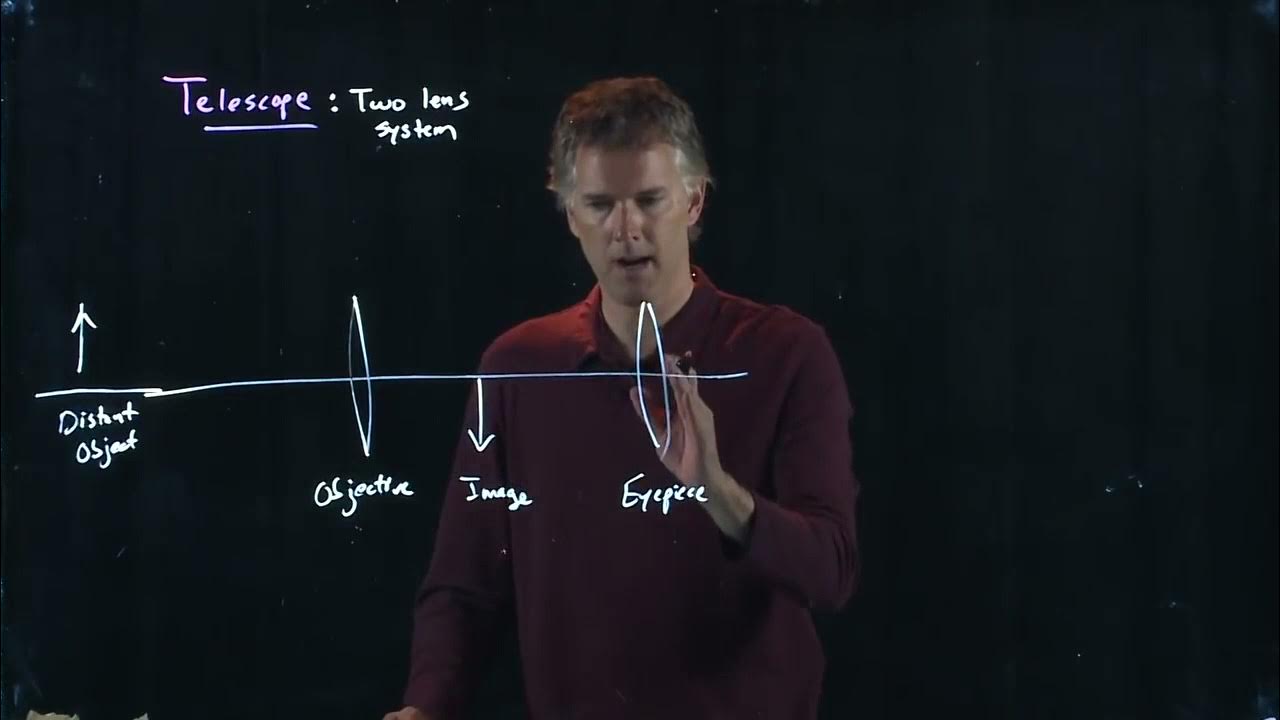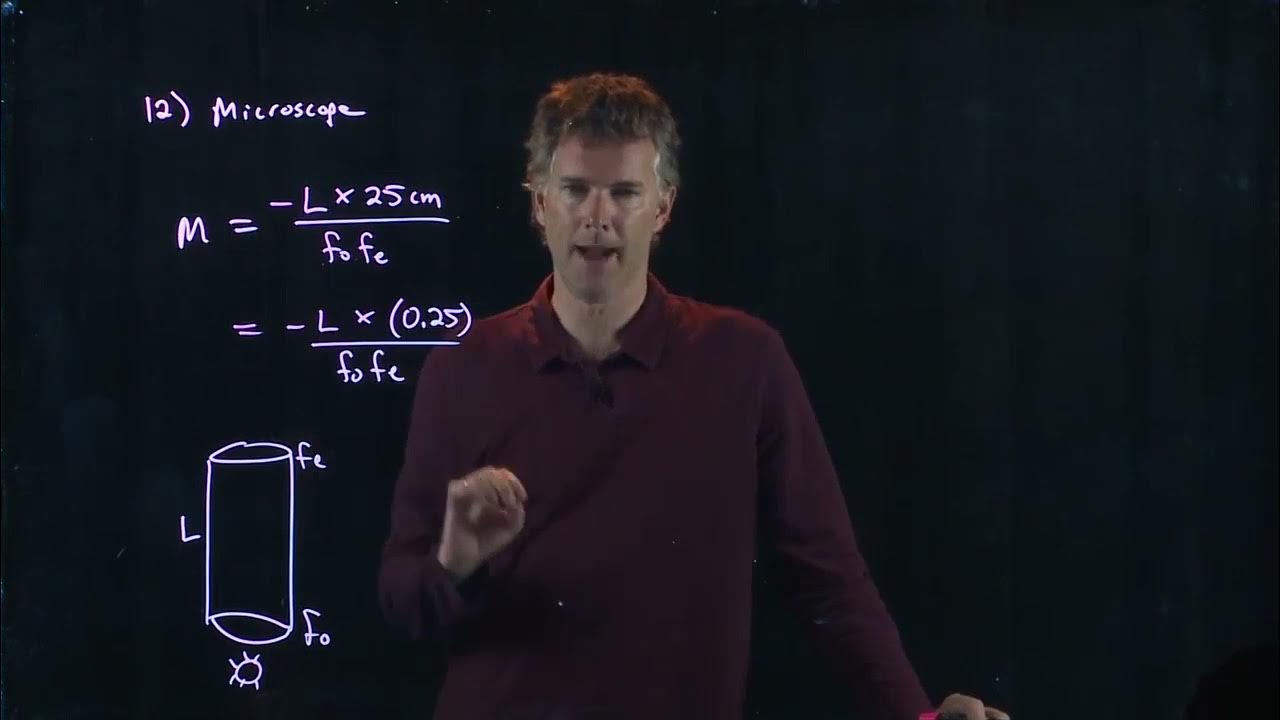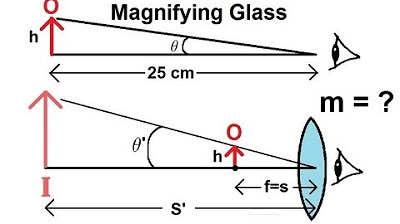Physics 59 Optical Instruments (2 of 20) The Telescope
TLDRThis lecture introduces the concept and function of a telescope, emphasizing its similarities and differences with a microscope. It explains the importance of the objective lens's focal length and its position relative to the eyepiece. The magnification of a telescope is calculated as the ratio of the objective's focal length to the eyepiece's, highlighted by an example. The lecture also clarifies that magnification is not the sole determinant of a telescope's quality; the size and quality of the objective lens are crucial for better light gathering and higher resolution images.
Takeaways
- 🌌 The main difference between a microscope and a telescope lies in the positioning of the lenses and their focal lengths, with the telescope having a long focal length for the objective lens and a short one for the eyepiece.
- 🔍 The objective lens of a telescope must have its focal length beyond the focal length of the eyepiece to ensure the focal points are overlapped, which is essential for telescope functionality.
- 📏 Rays from a distant object pass through the telescope's objective lens, refract, and form an image at the focal point, which then serves as the object for the eyepiece.
- 👀 The observer sees a virtual image that is much larger than the actual object, created by the rays bending down to the focal point of the eyepiece.
- 🔢 The magnification of a telescope is the ratio of the angle subtended by the image at the eyepiece to the angle subtended by the object at the objective lens, expressed as θe/θo.
- ➗ For small angles, the angular size can be approximated using the tangent function, which simplifies the magnification formula to the ratio of the image height to the focal distance of the eyepiece.
- 🆚 After simplification, the formula for telescope magnification is the ratio of the focal length of the objective lens (f0) to the focal length of the eyepiece (fe).
- 🌟 An example given in the script illustrates that a telescope with an objective lens focal length of 150 cm and an eyepiece focal length of 5 cm would have a magnification of 30.
- 🔑 Magnification alone is not the most important aspect of a telescope; the size and quality of the objective lens are crucial for light gathering and image clarity.
- 🔭 A larger objective lens allows more light to enter, resulting in a higher resolution and clearer image, which is more important than magnification for telescope quality.
- 📚 Understanding the principles of how a telescope works and how to calculate its magnification is fundamental to appreciating its capabilities and limitations.
Q & A
What is the main difference between a telescope and a microscope in terms of lens positioning?
-The main difference between a telescope and a microscope in terms of lens positioning is that in a telescope, the objective lens has a long focal length and the eyepiece has a short focal length, whereas in a microscope, both lenses tend to have a short focal length.
What is the requirement for the focal length of the objective lens in a telescope?
-The focal length of the objective lens in a telescope must be greater than the focal length of the eyepiece, and the focal points of both lenses must be overlapped.
How does the positioning of the lenses affect the image formation in a telescope?
-In a telescope, light rays from a distant object pass through the objective lens, refract, and form an image at the focal point on the other side of the lens. This image then becomes the object for the eyepiece, which further magnifies the image, creating a virtual image that is larger and perceived by the observer.
What is the formula for calculating the magnification of a telescope?
-The magnification of a telescope is calculated as the ratio of the focal length of the objective lens (f0) to the focal length of the eyepiece (fe), which can be expressed as M = f0 / fe.
Can you provide an example of calculating the magnification of a telescope with given focal lengths?
-Sure, if the focal length of the objective lens is 150 centimeters and the focal length of the eyepiece is 5 centimeters, the magnification (M) would be 150 cm / 5 cm, which equals 30.
Why is the size of the objective lens more important than the magnification in determining the quality of a telescope?
-The size of the objective lens is more important than the magnification because a larger objective lens allows more light to enter the telescope, resulting in a clearer, crisper, and higher resolution image.
What is the relationship between the angular size of an object and the magnification of a telescope?
-The angular size of an object is related to the magnification of a telescope in that the magnification is the ratio of the angle formed by the image of the second lens (eyepiece) to the angle formed by the object coming into the first lens (objective).
How does the height of the image formed by the objective lens relate to the magnification of a telescope?
-The height of the image formed by the objective lens (H prime) is used in the formula to calculate the angular size of the image formed by the eyepiece, which is then related to the magnification of the telescope.
What is the significance of the focal point in the context of a telescope's operation?
-The focal point is significant because it is the point where the light rays converge after passing through the objective lens, and it is also the point from which the rays emanate after being refracted by the eyepiece, contributing to the formation of the magnified image.
How does the script describe the process of light rays in a telescope?
-The script describes the process of light rays in a telescope as entering from a distant object, passing through the objective lens, refracting, and continuing parallel to the optical axis to form an image at the focal point, which then serves as the object for the eyepiece to further magnify.
Outlines
🔭 Understanding Telescopes and Their Magnification
The script introduces the concept of a telescope, comparing it with a microscope in terms of their basic components: an objective lens and an eyepiece. It emphasizes the difference in lens positioning and focal lengths, with the telescope's objective lens having a long focal length and the eyepiece a short one. The script explains the importance of the focal length of the objective being greater than that of the eyepiece and how the rays of light form an image through the telescope. The magnification of a telescope is described as the ratio of the angles formed by the image and the object, which can be simplified to the ratio of the focal lengths of the objective lens to the eyepiece. An example is given to calculate the magnification using specific focal lengths, highlighting the significance of the objective lens size for better light gathering and image resolution.
Mindmap
Keywords
💡Optical Instrument
💡Telescope
💡Microscope
💡Objective Lens
💡Eyepiece
💡Focal Length
💡Magnification
💡Optical Axis
💡Virtual Image
💡Resolution
💡Angular Size
Highlights
A telescope and a microscope share similar components, including an objective lens and an eyepiece, but differ in lens positioning and focal lengths.
The objective lens of a telescope has a long focal length, while the eyepiece has a short focal length.
The focal length of the telescope's objective must be greater than the focal length of the eyepiece to form a proper image.
The rays from a distant object are refracted by the telescope's objective lens to form an image, which then serves as the object for the eyepiece.
The eyepiece bends the light rays from the objective's image, creating a virtual image that appears larger to the observer.
The magnification of a telescope is the ratio of the angle subtended by the image to the angle subtended by the object.
For small angles, the angular size can be approximated using the tangent function, relating the height of the image to the focal distance.
The angular size of the image formed by the eyepiece is defined by the height of the image and the focal distance of the eyepiece.
The magnification formula simplifies to the ratio of the focal lengths of the objective lens to the eyepiece.
An example calculation shows that a telescope with an objective focal length of 150 cm and an eyepiece focal length of 5 cm has a magnification of 30.
Magnification alone is not the most critical aspect of a telescope; the size and quality of the objective lens are more important for image clarity and resolution.
A larger objective lens allows more light to enter the telescope, resulting in a clearer and higher resolution image.
The quality of the image observed through a telescope is determined more by the size of the objective lens rather than just magnification.
Understanding the relationship between the focal lengths and the positioning of lenses is crucial for utilizing a telescope effectively.
The lecture explains the fundamental principles behind how a telescope works, including the formation of images and the calculation of magnification.
The importance of the focal points being overlapped for the telescope to function properly is emphasized in the lecture.
The lecture provides a step-by-step explanation of how light rays are manipulated within a telescope to create a magnified image.
The virtual image formed by the telescope is the same size as the actual object, but appears larger due to the magnification effect.
Transcripts
Browse More Related Video

The Telescope | Physics with Professor Matt Anderson | M28-13

The Microscope | Physics with Professor Matt Anderson | M28-12

Focal Length of Eyepiece in a Microscope | Physics with Professor Matt Anderson | M28-22

Physics 59 Optical Instruments (3 of 20) The Microscope

How telescopes work | Class12 (India) | Physics | Khan Academy

Physics 59 Optical Instruments (1 of 20) Magnifying Glass
5.0 / 5 (0 votes)
Thanks for rating: